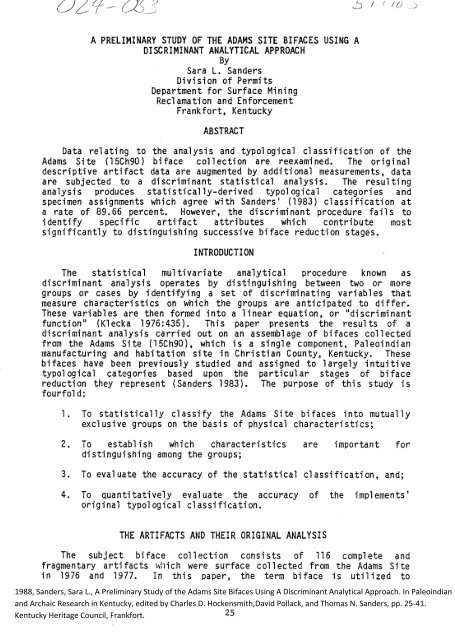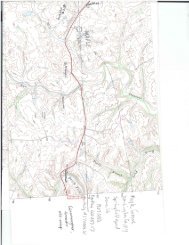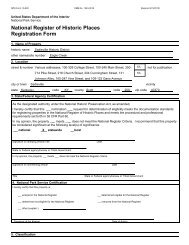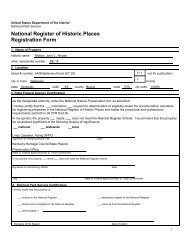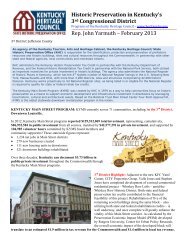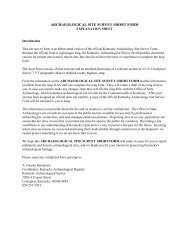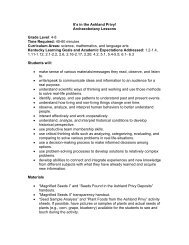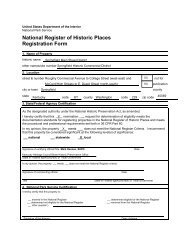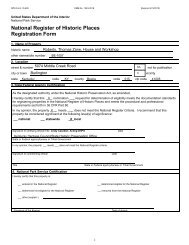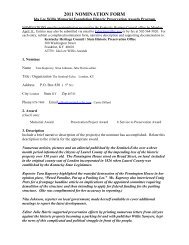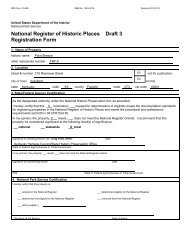A PRELIMINARY STUDY OF THE ADAMS SITE BIFACES USING A ...
A PRELIMINARY STUDY OF THE ADAMS SITE BIFACES USING A ...
A PRELIMINARY STUDY OF THE ADAMS SITE BIFACES USING A ...
Create successful ePaper yourself
Turn your PDF publications into a flip-book with our unique Google optimized e-Paper software.
.:J I I I() ~A <strong>PRELIMINARY</strong> <strong>STUDY</strong> <strong>OF</strong> <strong>THE</strong> <strong>ADAMS</strong> <strong>SITE</strong> <strong>BIFACES</strong> <strong>USING</strong> ADISCRIMINANT ANALYTICAL APPROACHBySara L. SandersDivision of PermitsDepartment for Surface MiningReclamation and EnforcementFrankfort, KentuckyABSTRACTData relating to the analysis and typological classification of theAdams Site (15Ch90) biface collection are reexamined. The originaldescriptive artifact data are augmented by additional measurements, dataare subjected to a discriminant statistical analysis. The resultinganalysis produces statistically-derived typological categories andspecimen assignments which agree with Sanders• (1983) classification ata rate of 89.66 percent. However, the discriminant procedure fails toidentify specific artifact attributes which contribute mostsignificantly to distinguishing successive biface reduction stages.INTRODUCTIONThe statistical multivariate analytical procedure known asdiscriminant analysis operates by distinguishing between two or moregroups or cases by identifying a set of discriminating variables thatmeasure characteristics on which the groups are anticipated to differ.These variables are then formed into a linear equation, or "discriminantfunction" (Klecka 1976:435). This paper presents the results of adiscriminant analysis carried out on an assemblage of bifaces collectedfrom the Adams Site {15Ch90), which is a single component, Paleoindianmanufacturing and habitation site in Christian County, Kentucky. Thesebifaces have been previously studied and assigned to largely intuitivetypological categories based upon the particular stages of bifacereduction they represent {Sanders 1983). The purpose of this study isfourfold:1. To statistically classify the Adams Site bifaces into mutuallyexclusive groups on the basis of physical characteristics;2. To establish which characteristics are important fordistinguishing among the groups;3. To evaluate the accuracy of the statistical classification, and;4. To quantitatively evaluate the accuracy of the implements•original typological classification.<strong>THE</strong> ARTIFACTS AND <strong>THE</strong>IR ORIGINAL ANALYSISThe subject biface collection consists of 116 complete andfragmentary artifacts \'t'ilich were surface collected from the Adams Sitein 1976 and 1977. In this paper, the term biface is utilized to25
describe chipped stone implements which have been flaked from opposingsurfaces. This definition includes specimens representing intermediatereduction stages as well as the finished products of flint knapping.While the Paleoindian occupants at the Adams Site produced a widerange of bifacial tools, including side and end scrapers, burins,knives, and choppers, an important aspect of their manufacturingactivities was the production of Clovis points. This assumption isbased upon the large number of these projectile points which have beencall ected from the Adams Site over the years by amateurs, and morerecently by profession a 1 archaeologists. This particular bifacecall ecti on has provided a unique opportunity to document the completesequence of Clovis point manufacture. In his analysis, Sanders (1983)traces the flow of material, Ste. Genevieve chert, from procurement ofthe locally available resource, through various blank and preformstages, concluding with the final fluting and edge grinding of thefinished Clovis point.Sanders (1983) adopted a modified version of Errett Callahan•s(1979) 10 stage biface reduction model in developing his typologicalcategories. Callahan•s model was chosen for use because its carefullydefined stages are based upon his numerous replication experiments.Sanders• somewhat more abbreviated model, consisting of sevenprogressive stages of manufacture (Figure 1) is described below.Prior to a discussion of these manufacturing stages, it is necessary11to define some terms. The term b 1 ank 11 is uti 1 i zed to represent anappropriately shaped piece of lithic material, showing little or nowaste, and being large enough to produce a tool. The shape and form ofthe projected implement usually cannot be determined from the blank11(Crabtree 1972:42). The term preform 11 is utilized in this paper toindicate an unfinished form of the desired artifact, usually larger and1 ack i ng the usual characteristics of the completed tool (Crabtree1972:85). The following discussion of a multistage biface reductionsequence is summarized from Sanders• (1983) analysis and report.Stage~ Procurement of the Lithic ResourceThis stage represents the act of deliberate selection of a chertresource for the purpose of reduction and tool manufacture. However,because a chert nodule or tablet is not a bi facially-worked implement,all artifacts falling into this data category are not considered in thesubsequent . discriminant analysis •Stage~ Obtaining the BlankThe next logical step in producing a tool entails the production orselection of a blank unit. Typically, these blank units consist ofeither unmodified, large flakes (spalls) detached from nodules ortablets, or biface cores. Sanders (1983:56) notes that the inhabitantsof the Adams Site apparently preferred to utilize spalls as the startingpoint of the biface reduction sequence. Twenty spall specimens wererecovered at 15Ch90, while only five biface cores were collected.Callahan (1979:66) has stated that the optimal size of a Clovis spallranges from 10-13 em in length, 7.5-10 em in width, 13-25 mm in26
BIFACECORESPALLor {J_~ySTAGE 1'-~-~STAGE2STAGE3STAGE4or-~STAGES--·~STAGE6Figure 1. Six Stage Biface Reduction Model (after Sanders 1983).27
thickness, and 170-255 grams in weight. Adams Site spalls tend to beshorter, narrower, and thicker than these ideal measurements, which arebased upon Callahan's extensive replication experiments. However, thesespalls may not represent optimal blanks. Sanders (1983:79) has statedthat all but one of these spalls were probably discarded as unsuitablefor biface manufacture, due to their extreme degree of curvature andextensive amount of cortex. Again, for reasons stated above, spalls andcores have not been included in the subject discriminant analysis.Stage II: Initial Edging of the BlankDuring Stage II, the selected blank unit is initially edged bydetaching flakes which span less than half the biface width. Theresulting flake scar intervals are wide and unevenly spaced. Stage IIbiface transverse sections are hexagonal, irregular, or lenticular.Callahan (1979:10) observes that Stage II specimens have "roughlycentered edge-angles of between 550-750 and a width/thicknessratio of 2.0 or more." Based upon the presence of deep flake scars andnumerous step fracture terminations and collapsed edges on the AdamsSite b 1 ank s, it is probab 1 e that these bifaces were produced by hardhammer percussion techniques (Sanders 1983:57).Stage I II: Primary Thinning of the BlankThis particular reduction stage entails the primary thinning of theblank unit to produce a biface which is lenticular in cross section.Flakes are removed from the edge up to, or slightly beyond, the bifacecenter, meeting or overlapping thinning flake scars from the oppositemargin. Flake scar edge intervals appear to be closer and moreregularly spaced than evidenced in Stage II bifaces. Sanders (1983:57)observes that Stage III implements demonstrate fiake scars with featheredge terminations, low incidence of gouging, and a decrease in theprevalence of crushed and collapsed edges. He interprets these bifacefeatures as hallmarks of the billet percussion technique. Adams SiteStage III bifaces are more regular in appearance, with pointed tips,straight to excurvate lateral edges, and straight or rounded bases.Callahan (1979:10) characterizes this category of bifacially workedspecimens as having a width/thickness ratio of between 3.0-4.0, and withaligned, centered edge angles of 400 to 60°.Stage IV: Secondary Thinning of the Clovis PreformThis stage in the biface reduction process involves the removal of1 ateral thinning flakes past the biface center, undercutting andremoving the opposing flake scars. This action removes the preform'smedian ridge and produces a biface with a flattened cross section. AStage IV biface shows detailed billet percussion work; flake scarintervals are close and regularly spaced. All surface irregularitieshave been eliminated~ and edge platforms are centered in relation to themedian plane. These Clovis preforms typically have pointed tips,excurvate sides, and rounded bases. Callahan (1979:10) recordswidth/thickness ratios greater than 4.0, and edge angles between 250and 450 for Stage IV bifaces.28
Stage i£ Final Shaping of the Clovis PreformReduction of the biface preform continues during this stage asbillet flaking and pressure retouch are combined to reduce width andgive the implement its final shape. In the case of bifacially workedtools not requiring fluting, Stage V represents the end of the reductionsequence.Stage VI: Fluting and Finishing the Clovis PreformFurther reductions in width are achieved at this point by flutingboth faces of the Clovis point preform. Finishing techniques includethe application of lateral pressure retouch and lateral/basal grinding.Incidences of multiple fluting of one or both faces are represented inthe Adams Site assemblage. While most of the specimens appear to havebeen fluted by direct billet percussion, a small number of the AdamsSite Clovis specimens show evidence of the punch technique of fluteremova 1 (Sanders 1983:59}.Stage VII: The Finished Clovis Fluted PointStage VII represents the end of the biface reduction sequence,culminating in a finished fluted Clovis projectile point. Finishedspecimens collected from the Adams Site are mostly broken and rejectedpoints. Understandably, successful Clovis projectile points would havebeen highly curated by Pal eoindi an inhabitants, and would be relativelyrare items of occurrence at archaeological sites.·These seven stages describe a biface reduction sequence which is inessence a continuum. Flint knapping is a linear, subtractive process,and from beginning to end the proposed implement is in a continuoustransition state (Collins 1975:16}. The transition is completed whenthe implement is finished and ready for hafting and/or use.Alternatively, the transition sequence can be terminated when theunfinished implement is discarded, or put to some other use than. theintended projectile point.In his analysis of the Adams Site bifaces, Sanders describes sevenmajor reasons for artifact discard or rejection: step fractures whichprevent bifacial thinning, deeply hinged terminations, fracture,overshots, longitudinal splitting, excessively thick biface edges, andraw material flaws (Sanders 1983:60-63). It must also be suspected thatsome preliminary stage bi faces were coopted for other uses due to theopportune need for a particular tool type. Of the 116 bifaces studied,only five specimens were considered to be successful executions. Fourof these successful forms were removed from the continuing reductionprocess and utilized as other tool types (choppers, side scrapers,drills, and knives}. However, Callahan (1974:25} emphasizes that thepresence of use wear on early stage biface implements does notnecessarily mean that the permanent termination of reduction wasintended. At any point during the reduction process, the implementcould be utilized for incidental functional activities, and thenreturned to the reduction process. Sanders (1983:82-125} also observesvarious degrees of end wear and edge modification on 29 of theunsuccessfully executed Adams Site bi faces~ Apparently, the prehistoricresidents at the Adams Site were learning to profit from their mistakes.29
Sanders• (1983) macroscopic analysis of the Adams .Site bifaciallyworked artifacts employs the seven above-referenced categories ofprogressive reduction stages. In determining the assignment ofindividual bifaces to particular classes, he recorded several metric andnon-metric observations. Measurements of maximum length, width, andthickness were recorded with vernier ~alipers, and rounded to thenearest millimeter. Artifact weights were recorded on electronicdigital display scales and rounded to the nearest tenth of a gram.Specimens weighing more than 200 grams were weighed on a U.S. PostalService scale. Edge angles were measured on the most representativearea of each lateral with a goniometer. The angle was read byoverlaying the goniometer to a sheet of polar coordinate graph papercalibrated in degrees. For fluted specimens, obverse and reversemaximum 1 ength and width measurements were recorded. These raw dataappear in Appendix Two of Sanders• (1983) thesis, 11 The Manufacturing ofChipped Stone Tools at a Paleo-Indian Site in Western Kentucky ...Additional more subjective, unpublished observations were noted bySanders (n.d.) for each biface as follows: overall shape, blade edgeshape, basal edge shape, transverse and longitudinal section shape,treatment of lateral and basal edges, type and form of flaking, cherttype, and heat treatment. On the basis of these continuous and nominaldata, he assigned the 116 Adams Site bifaces to the categories indicatedbel ow.StageIIIIIIVvVIVIISpecimen Number1,2,3,4,5,6,7,8,9,10,12,14,16,45,46,47,48,49,55,74,76,89,90,98,104,108,109,111,114,115,116 (n=31)11 '13 '15 '1 7' 18 '22 '24 '26 '51 '52' 56' 59' 60 '63 '64 '69' 73 '78 '82'83,84,86,93,94,96,105,106,107,110,112 (n=30)19,20,21 ,23,25 ,27 ,29 ,32 ,34,37 ,50 ,54 ,58 ,61 ,65 ,66 ,67' 70' 71'77,79,80,81 ,85,87,88,91 ,92,97,99,101 ,103 (n=32)28,57,62,68,72,113 (n=6)30,31 ,33,35,36,38,39,40,41 ,53,95,100,102 (n=l3)42,43,44,75 (n=4)DISCRIMINANT ANALYSIS:BACKGROUND INFORMATIONThe first direct archaeological application of the discriminantanalysis method apparently was Graham•s study of South Britain handaxes(Graham 1970). Using all handaxes recovered from 38 sites as a sampleof a homogeneous population, he derived canonical variates indicatingthe physical attributes which discriminated best between sites. Thisparticular multivariate method functions optimally in situations whereunits have already been divided into recognized groups, such as theAdams Site bifaces. Discriminant analysis discovers and emphasizes30
DISCRIMINANT ANALYSIS RESULTS:<strong>THE</strong> <strong>ADAMS</strong> <strong>SITE</strong> <strong>BIFACES</strong>With these basic concepts in mind, a specific discriminant analysiswas designed for the Adams Site biface collection. For the purposes ofthis analysis, the term group refers to individual biface reductionstage categories. The selection of variables, in this case artifactattributes, to use as predictors of group membership provedproblematical. As Read (1974:225) points out in his discussion of11typological derivations, that for a given set of artifacts, thereshould be a unique typology, if we knew what variables to measure ...Since no archaeologist has beenabTe to unquestionably identify one setof attributes as universally significant in terms of definingtypological categories, one must speculate concerning which attributesare important in assigning bifaces to particular reduction stages.In establishing the list of predictor attributes, it seemedreasonable to utilize the continuous and discrete measurements alreadyavailable from Sanders • 1983 analysis. These data were supplemented bynew measurements recorded during a reexamination of the Adams Siteartifact assemblage. Some existing categories of data have beenexcluded from the discriminant analysis (chert type, heat treatment, andflaking form) because the data lacked sufficient variation to providesignificant input. New measurements and computations were recorded foreach biface by the author of this paper, with assistance from ThomasSanders, and include width/thickness ratio, average edge angle, cortexpresence/absence, and percussion type. A complete 1 ist of theattributes utilized as predictors of bifacial reduction stage are givenbelow. It must be mentioned that an obvious and expected attribute,maximum artifact length, had to be eliminated from consideration due tothe high percentage (75%) of broken bifaces in the Adams Sitecollection. While it can be argued that artifact weight should beexcluded for the same reason, an admittedly arbitrary decision was madeto retain the weight measurements.Predictor Variables (abbreviations in parentheses)1. Maximum width (WIDTH)2. Maximum thickness (THICK)3. Width/Thickness ratio (W.T.)4. Weight (WEIGHT)5. Average edge angle (AV.ANGLE)6. Cortex (CORTEX)7. Overall shape: bipointed (SHAPEl), trianguloid (SHAPE2), elliptical(SHAPE3), undetermined (SHAPE4)8. Blade edge shape: excurvate (BLADElL straight (BLADE2), parallel(BLADE3), recurvate (BLADE4), incurvate (BLADES)32
9. Basal edge shape: square (BASEl), convex (BASE2), pointed (BASE3),concave (BASE4)10. Jransverse section shape: biconvex (TRANSl), plano convex (TRANS2),rhomboid (TRANS3), flattened (TRANS4), median ridged (TRANS5),biconcave (TRANS6), concave/convex (TRANS7)11. Longitudinal section shape: biconvex (LONGl), plano convex (LONG2),rhomboid (LONG3), flattened (LONG4), concave/convex (LONG5)12. Treatment of lateral edges: dulling (LATl ), grinding (LAT2),visible edge wear (LAT3), no visible edge wear (LAT4)13. Treatment of basal edge: beveled (BASALl), thinned (BASAL2), fluted(BASAL3), dulled (BASAL4), ground (BASAL5), striking platform(BASAL6), no treatment of basal edge (BASAL7)14. Percussion type: hard hammer (HARD), billet (S<strong>OF</strong>T)These metric and parametric data were encoded into a computer file.An intermediate step was undertaken to convert the discrete data tobinary codes of 0 or l, representing the presence or absence of traits.I elected to execute a direct, forced-entry discriminant analysis inwhich all variables, including those with missing data, are analyzedsimultaneously.As stated earlier in this paper, 75% of the Adams Site bifacecollection are fragmentary specimens. It is patently impossible toobtain a full set of measurements for incomplete specimens, so valuesfor certain parameters were recorded as missing data. Normally,discriminant statistical procedures do not operate on cases with missingvariable values, and such cases are eliminated from the testpopulation. However, the exclusion of biface specimens with missingdata from this particular study would have reduced the sample size to anunacceptably low number. To compound this problem, 100% of Sanders'(1983) Stages IV, VI, and VII biface collection consist of brokenspecimens. Also, in certain cases it seems undesirable to eliminateattributes with missing measurements from the 1 ist of predictorvariables. Attributes such as basal edge shape and basal treatmentobviously can be expected to contribute significantly to theidentification of particular reduction stages. Therefore, all specimenswith missing variable information were used for this discriminantanalysis.Because this statistical procedure has been designed to discriminateamong six groups of cases (biface reduction stages II-VI I), the SPssxprogram DISCRIMINANT accordingly produced five canoni ca 1 functions. Alist of standardized canonical discriminant coefficients, calculated foreach variable and function, appears in Table 1.As discussed previously, an examination of individual coefficientvalues does not provide a positive indication of which attributes aremost successful at predicting group membership. To make thisdetermination, it is necessary to interpret the pooled within-groupscorrelations between discriminating variables and canonical discriminant33
Table 1. Standardiz~dCanonical Discriminant Function Coefficients.WIDTHTHICKW.TWEIGHTAV.ANGLECORTEXSHAPE!SHAPE2SHAPE3BLADE!BLADE2BLADE3BLADE4BLADESBASElBASE2BASE3BASE4TRANS!TRANS2TRANS3TRANS4TRANS5TRANS6LONGlLONG2LONG3LONG4LATlLAT2LAT3LAT4BASALlBASAL2BASAL3BASAL4BASAL5BASAL6BASAL?HARDFUNC 1-1.14841-0.397600.916481.02457-o. 33240.-0.06470-0.14891-0.12345-0.405540.371150.396930.35759-0.01224-0.015600.12052-0.018520 .114890.098340.362640.17987-0.070250 146570.073250 034880.142340.26397-0.112840.379290.006280.13275-0.30241-0.15021-0.27120-0.000120.455790.164740.219030.05977-0.12850-0.08399FUNC 20.541821.174850.70739-1.27406-0.400930.058210.13942-0.010710.10648-0.23285-0.411040.19492-0.01308-0.141820.296620.287300.151050.28878-0.74008-0.15610-0.31807-0.00570-0.06355-0.620980.871900.288070.331640.318340.51788-0.553290.825940.90295-0.09842-0.02284-0.439870.302550.47137.-0.29831-0.205580.1611634FUNC 3-0.956931. 343750.91622-0.157400.130030.162280.261710.318130.31284-0.08701-0.117600.304010.06594-0.15494-0.35200-0.57923-0.307360.15531-0.39509-0.21462-0.204530.37071-0.179580.01019-0.37592-0.576480.37131-0.381250.09534-0.260180.121510.022270.089430.26642-0.043270.702140.18961-0.12728-0.270640.04163FUNC 40.89867-1.24176-1.137220.232820,056700.00531-0.30528-0.15640-0.324440.596610.279550.35628-0.138590.00815-0.36056-0.276920. 03202-0.09856-0.014010.28832-0.070870.373140. 029320.088430.245250.43600-0.011890.41737-0.33353-0.42860-0.64124-0.511130.280370.362260.356470.313220.555920.262130.39878-0.05679FUNC 5-0.17704-0.66823-0.595360.63101-0.376020.32037-0.308230.071780.05071-0.184190.02174-0.163240.447410.156010.05885-0.405390.16217-0.326830.305430.304320.03594-0.044180.03229-0.14817-0.24853-0.204700.000000.246871. 328940.451731.174771.68840-0.044780.12691-0.03626-0.239520.318620.151320.15819-0.15488
Table 2. Pooled Within Groups Correlations Between DiscriminatingVariables and Canonical Discriminant Functions (Variables ordered bysize of correlation within function).FUNC 1 FUNC 2 FUNC 3 FUNC 4 FUNC 5THICK -0.44044* -o. 04115 0.10242 0.04343 -0.04064W.T 0.41401* 0.25850 -0.04916 -0.23187 -0.29699AV.ANGLE -0.37861* -0.17250 0.24217 0.04108 -0.12478WEIGHT -0.30375* -0.01195 0.04262 0.04577 -0.01897HARD -0.30340* 0.06833 -0.17424 0.16934 -0.11311S<strong>OF</strong>T 0.30340* -0.06833 0.17424 -0.16934 0.11311CORTEX -0.25847* -0.05995 0.14462 -0.05945 0.01428SHAPE3 -0.24986* -0.08762 0.21754 -0.12582 0.03511LONG3 -0.16505* -0.05788 0.14370 -0.08311 0.02319TRANS3 -0.13937* -0.04887 0.12134 -0.07018 0.01958LONG4 0 .13294* -0.01702 0.02657 0.01824 -0.04502BASAL7 -0.09886* -0.01735 0.05222 -0.05751 -0.01645LONGS -0.08748* -0.01721 0.03377 0.01635 0.01367BLADES -0.06777* -0.02377 0.05900 -0.03413 0.00952LAT2 0.09082 -0.42128* -0.04440 -0.05589 -0.14595LAT4 0 0 01132 0.15122* -0.13153 0. 09772 0.14930TRANS7 0.05502 0.09877* 0.00273 0.07294 -0.01450BASAL6 -0.00193 0.07676* 0.02717 0.06776 -0.00514BASAL4 0.08348 0.06445 0.35280* 0.20082 -0.03807TRANSl 0.01102 0.04954 -0.26166* -0.21163 -0.00183BASE4 0.03441 -0.08280 0.20451* 0.05479 -0.10997LAT1 0.06776 0.05720 0.18620* -0.01221 0.05731TRANS4 0.03680 0.02627 0.18166* 0.13681 0.00288BLADE3 0.05857 0.05177 0.16783* -0.00642 -0.08673S!-iAPE4 0.03979 0.02762 -0.15440* -0.05092 0.09953BASE3. -0.02985 0.03282 -0.08745* 0.08471 -0.02690BASAL5 0.06289 -0.02283 -0.03110 0.31444* 0.09398SHAPE2 0.10006 . -0.02928 0.11274 0.19594* -0.00172BLADE! -0.02995 0.05426 -0.15016 0.16307* 0.03484BASALl 0.05112 0.00627 0.07641 0.15318* -0.00532BASAL2 -0.03914 0.05046 0.12585 0.14741* 0.05662LONG2 0.04700 -0.02532 -0.00954 0.14285* 0.10592LONG1 -0.04143 0.07947 -0.10423 -0.12793* -0.088237RANS2 -0.04219 0.03751 0.05717 0.10930* 0.07700LAT3 -0.08857 0.04058 0.07749 -0.09203* -0.02927BLADE4 -0.02549 -0.02802 -0.01391 -0.12825 0.37581*WIDTH· -0.25041 0.20213 -0.14745 0.07186 -0.33313*BASAL3 0.13554 -0.08566 0.09030 0.21346 -0.24968*TRANS6 0.08916 -0.20576 0.20207 0.07933 -0.24560*..TRANS5 -0.04704 -0.01178 -0.03599 0.02955 0.22173*BASE2 -0.05378 0.12854 -0.13036 0.09057 -0.19054*SHAPE! 0.00136 0.07410 -0.12580 -0 .11194 -0.15919*BASEl -0.01728 0.02506 0.15091 -0.04829 0.15284*BLADE2 -0.02575 -0.09556 0.06184 -0.01372 -0.09780*36
Table 3. Biface Specimen Group Assignments Utilizing StatisticallyDerived Reduction Stages.CASE MIS ACTUAL HIGHEST PROBABILITY 2ND HIGHESTSEQNUM VAL SEL GROUP GROUP P(D/G) P(G/D) GROUP P(G/D)1 2 2 0.2630 1.0000 3 0.00002 2 2 0.4454 1.0000 3 0.00003 2 2 0.1395 1.0000 3 0.00004 2 2 0.0976 0.5868 3 0.41315 2 2 0.3650 0.9945 3 0.00556 2 2 0.4673 0.9968 3 0. 00327 2 2 0.3085 1. 0000 3 0.00008 2 2 0.5308 1.0000 3 0.00009 2 2 0.4212 1.0000 3 0.000010 2 2 0.7368 0.9999 3 0.000111 3 3 0.3801 0.9965 2 0.003312 2 2 0.7512 0.9988 3 0.001213 3 3 0.5005 0.9811 4 0.009714 2 2 0.0066 0.9213 3 0.078715 3 3 0.8941 0.9990 4 0.001016 2 2 0.8001 1.0000 3 0.000017 3 3 0.9728 0.9659 4 0.034118 3 3 0.4248 0.9950 4 0.004619 4 4 0.8968 0.9616 3 0.038320 4 4 0.6272 0.8516 3 0.147821 4 4 0.8623 0.9848 3 0.015122 3**4 0.7617 0.6275 3 0.368123 4 4 0.5431 0.8663 3 0.133724 3 3 0.3837 0.8622 4 0.137825 4 4 0.7418 0.9911 3 0.008226 3 3 0.1479 0.9981 4 0.001227 4 4 0.8502 0.7145 3 0.284928 5 5 0.8856 0.9985 4 0.001529 4**6 0.7014 0.9694 4 0.028430 6 6 0.9550 0.9997 4 0.000331 6 6 0.9463 0.9995 4 0.000532 4**6 0.3273 0.5741 4 0.425833 6 6 0.5502 1.0000 4 0.000034 4 4 0.4640 0.9511 6 0.046335 6 6 0.3624 1.0000 4 0.000036 6 6 0.5738 0.7002 4 0.264137 4 4 0.7264 0.9934 5 0.004638 6 6 0.6772 1.0000 4 0.000039 6 6 0.8352 0.9965 4 0.003540 6**4 0.9480 0.9895 6 0.008241 6**5 0.7597 0.9703 4 0.025442 7 7 0.9196 1.0000 5 0.000043 7 7 0.8907 1.0000 5 0.000044 7 7 0.7466 1.0000 5 0.000045 2 2 0.3005 1.0000 3 0.000046 2 2 0.5297 1.0000 3 0.000047 2 2 0;0048 1.0000 3 0.000048 2 2 0.7414 1.0000 3 0.000049 2 2 0.6106 1.0000 3 0.000050 4 4 0.7195 0.9985 3 0.000751 3' 3 0.2446 0.9438 4 0.056152 3 3 0.2929 0.9920 2 0.007653 6 6 0.3721 1.0000 4 0.000054 4 4 0.1812 0.9997 3 0.000255 2 2 0.0505 0.6306 3 0.359656 3 3 0.0534 0.9994 2 0.000657 5 5 0.9537 1. 0000 4 0.000058 4 4 0.7270 0.8045 3 0.122559 3 3 0.8150 0.9995 4 0.000560 3 3 0.9912 0.9702 4 0.029861 4 4 0.8827 0.8644 3 0.135362 5 5 0.2186 0.9999 4 0.000163 3 3 0. 7.318 0.9924 4 0.007264 3**4 0.9486 0.9971 3 0.002565 4**3 0.8233 0.6549 4 0.342237
Table 3 (continued). ,66 4 4 0.3473 0.9977 6 0.001267 4 4 0. 0232 0.9936 3 0.004968 5 5 0.6196 0.6896 4 0.275669 3 3 0. 8911 0,9895 4 0.009970 4**5 0.6916 0.9224 4 0.077371 4 4 0.6875 0.7780 5 0.169572 5 5 0.9361 0.9929 4 0.006973 3 3 0.3131 0.9132 5 0.071974 2 2 0. 17 80 1.0000 3 0.000075 7 7 0.8921 1.0000 5 0.000076 2 2 0.0813 1.0000 3 0.000077 4 4 0.6090 0.9989 5 0.000878 3 3 0.0518 0.8422 4 0.157879 4 4 0.7122 0.8557 3 0.088480 4 4 0.6733 0.9968 5 0.002981 4 4 0.9548 0.9897 3 0.010082 3 3 0.6734 0.9884 4 0. 011683 3 3 0.5935 0.5142 4 0.485284 3 3 0.0717 0.9966 4 0.003485 4 4 0.3781 0.5383 3 0.460686 3 3 0.2815 0.9883 4 0.011787 4**3 0.7001 0.6710 4 0.329088 4**6 0.8696 0.9773 4 0.022689 2 2 0.6407 1.0000 3 0.000090 2 2 0.9766 0.9999 3 0.000191 4 4 0.3941 0.4952 5 0.314792 4 4 0.9147 0.9674 3 0.030793 3 3 0.5460 0,5535 4 0.446094 3 3 0.4707 0.9894 4 0.010695 6 6 0.3438 1. 0000 4 0.000096 3 3 0.7935 0.9900 4 0.010097 4 4 0.6059 0,9982 3 0.001098 2 2 0.3585 0.9989 3 0. 001199 4**3 0.3600 0.6693 4 0.3307100 6 6 0.5723 0.7506 4 0.2490101 4 4 0.3999 0.9948 6 0.0034102 6 6 0.6661 1.0000 4 0.0000103 4**6 0.4814 0.5875 4 0.4100104 2 2 0.8783 1.0000 3 0.0000105 3 3 0.6596 0.9953 2 0. 0038106 3 3 0.6414 0.9895 4 0.0067107 3 3 0.5776 0.8734 4 0.1227108 2 2 0.9307 1. 0000 3 0.0000109 2 2 0.1380 1. 0000 3 0.0000110 3 3 0.7303 0.9985 4 0.0009111 2 2 0.4459 0.9999 3 0.0001112 3 3 0.8648 0.9989 4 0,0011113 5 5 0.7874 1. 0000 4 0.0000114 2 2 0.8459 1.0000 3 0,0000115 2 2 0.9410 0.9999 3 0.0001116 2 2 0.6446 1.0000 3 0.000038
(.;..)~cAN0NIcALDIscRIMINANTFuNcTI0N2OUT XIIIII12.08.04.0. 0-4.0I-8.0 +IIIII-12.0OUTOUT -12.0 -8.0 -4.0 .0 4.0 8.0 12.0 OUTx---------+---------+---------+---------+---------+---------+---------+---------x+IIIII+IIIII+IIII 11I 11 1 1 1+ 11 111I 111*11 11I 1 111 1I 1II 1+IIII22212222 32 3352 33323 552 *2333* 43*55XIIIII+IIIII+IIIII+IIIII+IIIII+III56I*I6 6 +IIIII222333 333 5 532243*552 34 43+ +IIIIIIIIIIX . , Xx---------+---------+---------+---------+---------+---------+---------+---------xOUT -12.0 -8.0 -4.0 .0 4.0 8.0 12.0 OUTFigure 2. All- Groups Scatterplot- * Indicates a Group CentroidCanonical Discriminant Function 1.
Table 4. Actual Group Membership Versus Predicted Group Membership.NO. <strong>OF</strong> PREDICTED GROUP MEMBERSHIPACTUAL GROUP CASES 2 3 4 5 6 7-------------------- ------ -------- -------- -------- -------- -------- --------GROUP 2 31 31 0 0 0 0 0100.0% 0.0% 0.0% 0.0% 0.0% 0.0%GROUP 3 30 0 28 2 0 0 00.0% 93.3Y. 6.7% o.or. 0.0% o.or.GROUP 4 32 0 3 24 1 4 00.0% 9.4% 75.0% 3.1% 12.5% 0.0%GROUP 5 6 0 0 0 6 0 00.0% 0.0% 0.0% 100.0% 0.0% 0.0%~GROUP 6 13 0 0 1 1 11 00 0.0% 0.0% 7.7% 7. 7% 84.6% 0.0%GROUP 7 4 0 0 0 0 0 40.0% 0.0% 0.0% 0.0% 0.0% 100.0%PERCENT <strong>OF</strong> -GROUPED- CASES CORRECTLY CLASSIFIED: 89.66%
to transfer intact to other researchers. Consistent classificationtechniques, vital if data are to be comparable, are difficult toachieve. Statistical procedures such as discriminant analysis offer amethod of obtaining more reliable and objective results from the use ofparticular typologies.While the stated goals of this study have been realized, thisresearch represents only a preliminary reexamination of the Adams Sitebiface collection. Future research will include a more intenseexamination of individual artifact attributes in an effort to moreaccurately identify those vari ab 1 es which contribute most to thedelineation of reduction stages. This effort will entail the executionof a stepwise discriminant analysis, and the interpretation of pooledwithin-groups correlation matrices to identify highly correlatedvariables. It is anticipated that the ultimate conclusion of this studywill success fully demonstrate how quanti ta ti ve methodologies can enhancethe understanding of cultural processes.41


